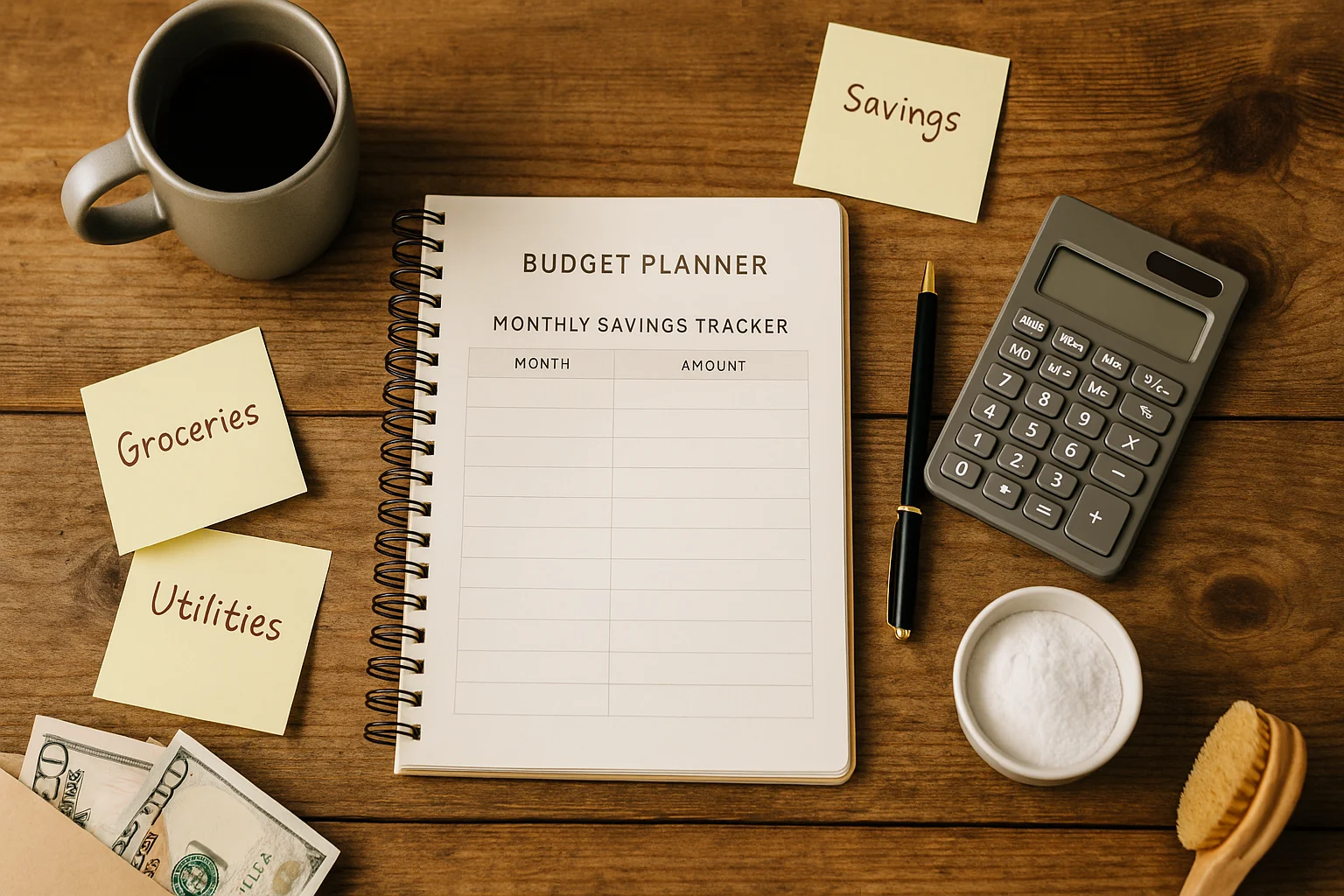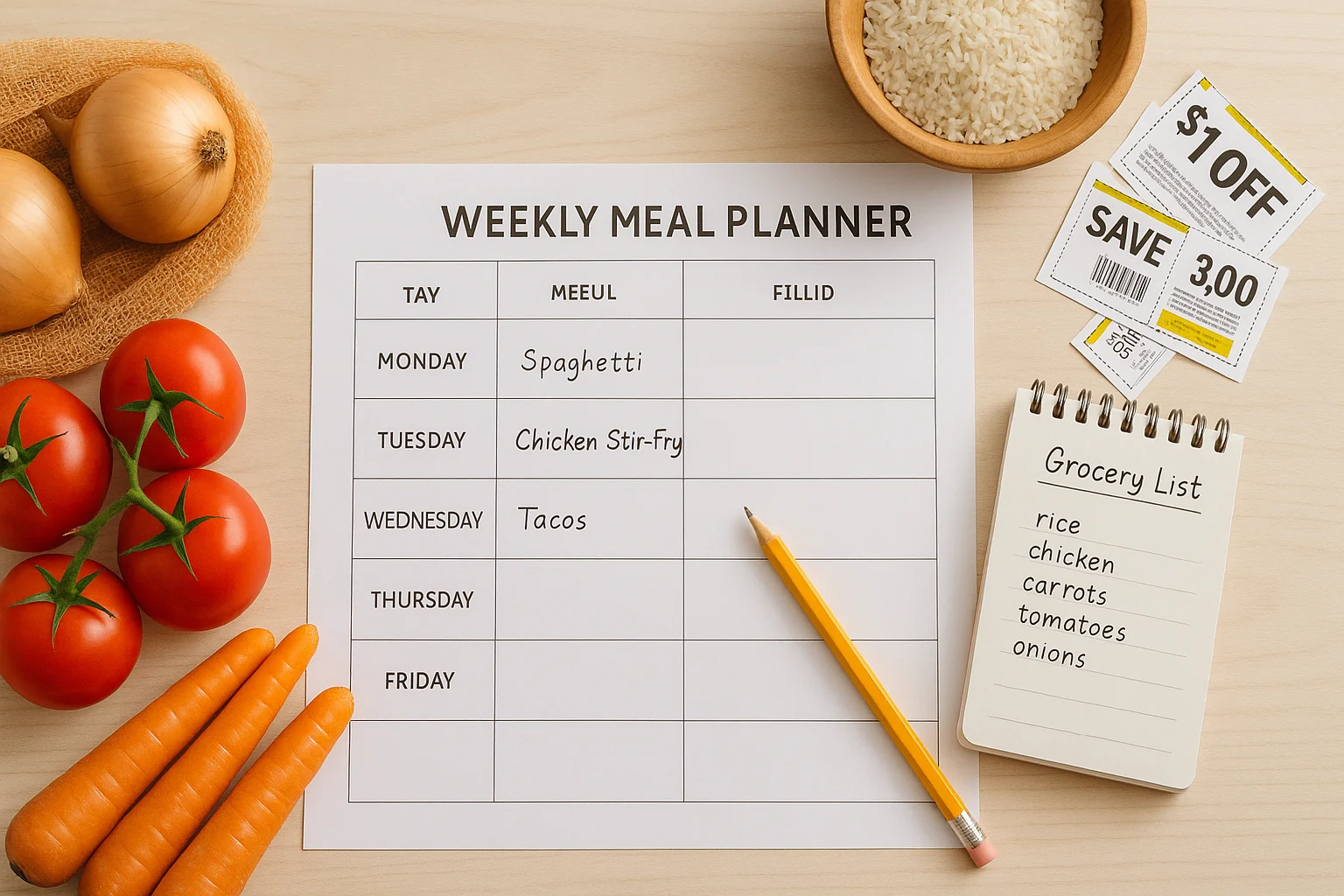
Many Americans still struggle to keep a $1,000 cushion. You don’t have to be one of them. Frugal living isn’t about giving up what you love—it’s about smart choices that unlock financial freedom and a simpler life. These smart frugal tips show how to save money at home, at the store, and on the go. Let’s get started.
Take the Frugal Living Quiz!Table of Contents
- Money-Saving Tips: Quick Wins You Can Use Today
- What Is Frugal Living? A Guide to Saving Smart
- Budget Basics: Master Your Money
- Grocery Hacks: Eat Well, Spend Less
- Home Savings: Efficiency & DIY
- Senior Budget Tips: Simple, Low-Stress Savings
- Smart Spending & Daily Habits: Beyond the Big Bills
- The Money-Saving Mindset
- How Frugal Are You? Quiz Time!
- Frequently Asked Questions
- Conclusion: Your Path to a Richer, Simpler Life
Frugal Living Tips: Quick Wins You Can Use Today
- Do a 10-minute subscription audit—cancel or pause at least one.
- Plan three dinners from what’s already in your pantry.
- Set the thermostat 1–2° more efficient; switch two bulbs to LED.
- Make coffee at home this week; bank the difference.
- Price-check one staple by unit price and switch to the best value.
Pick one tip today, not all five—small wins stick.
What Is Frugal Living? A Guide to Saving Smart
Many people assume frugal living means clipping coupons or saying no to everything. In reality, it’s about thoughtful choices that stretch every dollar. When I first tried it, cutting unused subscriptions and planning meals saved me about $500 in a month. The point isn’t deprivation; it’s aligning spending with what matters—paying down debt, building savings, or funding a trip you’ll remember. Here’s why this approach works.
Why Choose a Thrifty Lifestyle?
People choose a thrifty lifestyle for different reasons. Sometimes it’s about making ends meet; sometimes it’s a plan for big goals like early retirement or college savings. In plain terms, it helps you:
- Financial Freedom: Spend less than you earn so you can pay off debt, save, and invest—less stress, more options. 💰
- Less Stress: Money worries fuel anxiety. Frugal living puts you back in control, which is where peace of mind starts.
- Environmental Benefits: Buy less and reuse more to cut waste—good for your wallet and the planet. 🌎
- Focus on What Matters: Skip the trends and put your money toward experiences, relationships, and growth.
- Build Resilience: Resourceful habits make you sturdier when money surprises show up.
Frugal vs. Cheap: Understanding the Difference
It’s crucial to know that frugal living isn’t about being cheap. While both aim to save money, their approaches differ significantly.
Being Cheap: Choosing the lowest price regardless of quality or consequences. For example, buying flimsy shoes that break in a month, forcing repeated purchases. The mindset is: “How can I spend the least now?”
Being Frugal: Prioritizing value. A frugal person might spend more upfront on durable shoes that last years, saving money long-term. Or, they might repair shoes instead of replacing them. The mindset is: “How can I get the best value and make this last?”
“Frugality is enjoying the virtue of getting good value for every dollar spent. It’s not about deprivation, but optimization.”

Budget for a Frugal Lifestyle: Master Your Money 💰
These budget habits make frugal living feel doable.
One of the most effective frugal living tips is to master your finances through intentional budgeting, spending, and saving. Before you can save in every area, you need a clear picture of your finances. That starts with budgeting, tracking spending, and setting goals. For instance, Jane, a single mom, saved $1,200 last year by budgeting and cutting dining out. Let’s break it down.
Budgeting Like a Pro: Know Your Money’s Flow
A budget isn’t a straitjacket; it’s a map. Without one, it’s hard to see where your paycheck goes. Try this simple setup:
- Calculate Income: Add up your take-home pay from every source.
- List Fixed Expenses: List rent or mortgage, loans, insurance, subscriptions.
- Track Variable Expenses: Track the flex costs—groceries 🥦, utilities, transport, dining out 🍕, entertainment 🎉, personal care.
- Compare Income vs. Expenses: If there’s extra, save/invest; if not, trim; if it’s even, cut a little so you’re not living paycheck to paycheck.
Popular Budgeting Methods that Work
These approaches make frugal living easier to sustain:
- 50/30/20 Rule: 50% needs (housing, groceries), 30% wants (dining, hobbies), 20% savings/debt repayment.
- Zero-Based Budgeting: Assign every dollar a job (expenses, savings, debt) until income minus expenses equals zero.
- Envelope System: Use cash in labeled envelopes for variable expenses. Once empty, stop spending in that category.
Tracking Spending: Tools and Tips
Tracking ensures your budget works. Use apps like YNAB to categorize transactions automatically, or explore MyMoney.gov for free budgeting worksheets. Alternatively, try a Google Sheet or a notebook. Be honest—those $5 coffees add up! ☕
Setting SMART Financial Goals
A frugal mindset thrives on purpose. Set SMART goals (specific, measurable, achievable, relevant, time-bound) like:
- Building a 3-6 month emergency fund.
- Paying off $5,000 in credit card debt 💳 in 12 months.
- Saving $10,000 for a house down payment 🏡 in 2 years.
- Funding a $2,000 dream vacation ✈️.
Write goals down and review them daily for motivation.
Tax-time win: If you usually pay for software, you may qualify to file for $0. See the step-by-step guide to avoiding tax filing fees in 2025 (IRS Free File, VITA, and other no-cost options).
Debt Reduction Strategies That Stick
High-interest debt, like credit cards, blocks financial freedom. Try these methods:
- Debt Snowball: Pay off smallest debts first for momentum.
- Debt Avalanche: Tackle highest-interest debts to save on interest.
- Stop New Debt: Live within your means and avoid new credit card charges.
If debt feels overwhelming, a nonprofit credit counselor can help you plan—many offer a free first session.
Building an Emergency Fund
An emergency fund is your safety net for unexpected costs. Aim for 3-6 months of expenses. Set up automatic transfers to a savings account, even $20 per paycheck. Small contributions grow fast.
Grocery Hacks to Live Frugally: Eat Well, Spend Less 🍎
These swaps are core to frugal living without sacrificing nutrition. Many wins come from simple choices—planning meals, comparing unit prices, and choosing DIY vs buy wisely. Here’s how to keep more in your wallet.
How to Master Meal Planning
Meal planning stops impulse buys and food waste. For the full playbook, see frugal meal planning for $50 a week. Start here:
- Check Your Pantry: Shop your pantry first to use what you already have.
- Browse Sales Flyers: Scan store sales and build meals around the best deals.
- Choose Simple Meals: Pick easy meals built on budget staples—rice, beans, pasta.
- Plan for Leftovers: Cook a bit extra at dinner and pack tomorrow’s lunch.
- Make a Shopping List: Make a list and stick to it in the store.
Cooking at Home: Unlocking Huge Savings
Thrifty meal planning pays off fast. Cooking simple food at home beats prepackaged meals and takeout on cost and nutrition. Master a few basics (stir-fries, soups), batch cook for the week, and pack lunches. Brewing coffee at home can add up to hundreds a year—often around ~$1,000—depending on what you buy and how often. ☕
Estimate check: café drinks ($4–$6+) vs. homemade (~$1–$1.50). Your savings will vary by prices and frequency.
Thrifty Meal Planning: DIY vs Buy Savings
Use thrifty meal planning DIY vs buy savings to lower your food costs. Make instead of buy when it’s truly cheaper and not time-intensive: brew coffee at home, prep oatmeal vs single-serve packets, and portion snacks from bulk bags. Buy when quality or time wins: rotisserie chicken on sale, house-brand pasta sauce, or frozen veggies for less waste. Track three swaps this week and note the savings.
This post contains affiliate links. If you buy through our links, we may earn a commission at no extra cost to you. Learn more.
Build This Week’s 5-Day Meal Plan
Plan family-friendly meals and generate a smart grocery list that fits your budget and routine.
50% off annual plan (see details on partner page).

Smart Shopping Strategies
Your grocery trip is where planning pays off. To dive deeper into grocery savings, check out these smart grocery shopping strategies. Try these tips:
- Use a List: Avoid impulse buys by sticking to your plan.
- Shop Full: Never shop hungry to resist expensive snacks.
- Compare Unit Prices: Check price per ounce for the best deal.
- Embrace Store Brands: Generic items are often just as good but cheaper.
- Buy in Bulk Wisely: Stock up on non-perishables like rice or canned goods.
- Shop the Perimeter: Focus on fresh produce, dairy, and meat.
- Use Coupons: Leverage store loyalty programs and digital coupons.
| Category | Frugal Tip | Potential Savings |
|---|---|---|
| Produce | Buy seasonal produce; check farmers’ markets; freeze excess. | 20-30% |
| Meat | Buy cheaper cuts; incorporate plant-based meals; buy on sale & freeze. | 25-40% |
| Dairy/Eggs | Choose store brands; buy larger containers of milk/yogurt. | 10-20% |
| Pantry Staples | Buy in bulk (rice, beans, pasta); use store brands. | 15-30% |
| Snacks/Drinks | Make your own (popcorn, fruit); avoid soda and bottled water. | 30-50%+ |
Reducing Food Waste
Wasted food is wasted money. Store food properly, use leftovers creatively (e.g., chicken into tacos), and compost scraps. Designate an “Eat Me First” fridge spot for expiring items.
Budget-Friendly Gardening
Growing your own food is rewarding. Start small with herbs or lettuce in pots. Join community gardens if you lack space. Foraging edible wild plants can also save money, but always verify safety.
Save Money at Home: Efficiency & DIY 🏠
Smart habits help you cut home costs fast—then keep those savings rolling.
Your place is a big expense, but efficiency and DIY can slash costs. Here’s how to make your space budget-friendly. For more ideas, see these energy-saving tips.
Energy Efficiency: Lowering Utility Bills
Small changes cut electricity and gas bills. Seal leaks around windows, adjust your thermostat, use LED bulbs, and unplug electronics. Run full loads in dishwashers and washers to save energy.
Water Conservation Tips
Water bills add up. Take shorter showers, fix leaks promptly, and install low-flow fixtures. Water gardens early or late to reduce evaporation, and use rain barrels for plants.
DIY Repairs to Save More
Skip professional fees by learning basic repairs. A thrifty mindset empowers you to be resourceful. Fix leaky faucets, replace light switches, or paint rooms yourself. YouTube tutorials are a goldmine for DIY projects. Start simple and stay safe!
Decluttering & Minimalism
A minimalist lifestyle saves money. Buy less, declutter regularly, and sell unused items. Borrow or rent tools instead of buying. For budget-friendly cleaning, explore these frugal cleaning hacks. To decorate affordably, check out this frugal home furnishing guide. Focus on experiences over possessions for a richer life.
Home Maintenance Checklist
A little maintenance now prevents big repair bills later:
- Monthly: Clean filters, check smoke detectors.
- Quarterly: Test GFCIs, clean garbage disposal.
- Annually: Inspect roof, clean gutters, service HVAC.

Cheap Living for Seniors: Simple, Low-Stress Savings
On a fixed income, small optimizations compound—these cheap living for seniors ideas protect cash flow without sacrificing quality of life.
- Apply for reduced utility rates and medical discount cards.
- Choose low-prep, high-protein pantry meals (beans, tuna, eggs).
- Swap or borrow household items via local community groups.
If it feels overwhelming, try one change per week and ask a friend or family member to keep you company while you set it up.
Smart Spending & Daily Habits: Beyond the Big Bills 🛍️
Everyday money-smart choices add up—from transportation to pet care. Here’s how to save on everyday expenses.
Family Budgeting: Involving Everyone
Raising a family? Budgeting with kids turns saving into a game and builds habits that stick. Let them help pick meals or tackle a small DIY—ownership beats lectures.
Frugal Transportation Tips
Getting around is pricey. Take transit, bike, or walk when it’s close. Keep your car tuned, carpool, and batch errands so you’re not crisscrossing town.
Frugal Entertainment & Hobbies
Fun can be free. Think parks, libraries, and community events. Borrow books and movies, host a potluck, or make a simple DIY gift. Make a short “free fun” list for your town and rotate one idea each week.
Clothing & Personal Care
Build a capsule wardrobe with versatile pieces. Shop thrift stores, mend clothes, and make DIY beauty products like sugar scrubs. Simplify your routine to save.
Frugal Pet Care: Save Money on Your Dog/Cat
Vet bills and supplies add up fast. Use these quick wins, then dive deeper with our full guide to frugal pet care.
- Preventive beats reactive: Keep up with vaccines, flea/tick meds, and basic dental care to avoid big emergencies.
- Buy smart: Compare unit prices on food, rotate store brands, and use autoship discounts—only if you’ll use it.
- DIY where sensible: Do basic grooming at home, portion bulk treats, and swap toys with friends.
- Shop services: Call 2–3 clinics for quotes; ask about wellness plans and low-cost shot clinics.
Thoughtful Gifts & Celebrations
Celebrate without overspending. Give experiences, DIY gifts, or group gifts. Focus on companionship, not lavish spending, for birthdays and holidays.
Cutting Subscriptions
Audit subscriptions monthly. Cancel unused ones, share family plans, or rotate services to save. This can free up hundreds annually.
The Money-Saving Mindset 🧘♀️
Frugal living is a mindset—find joy in simplicity and adapt with purpose.
Finding Joy in Less
True wealth is about experiences, not stuff. Practice gratitude, prioritize trips or classes over possessions, and learn skills like sewing or cooking to save.
Community & Sharing
Frugal living thrives in community. Borrow tools, swap skills, or join Freecycle groups. For free items, check out this best freebies for frugal living list. Participate in low-cost local events to stay connected.
Continuous Learning
Stay curious. Read frugal living blogs, listen to podcasts, and experiment with new hacks. For inspiration, see these motivational budgeting quotes. Review your budget regularly to adapt to life changes.
How Frugal Are You? Quiz Time! 📊
Curious how frugal you really are? Take this quiz to uncover strengths and growth areas. Click an answer for each question to track your progress!
Frequently Asked Questions
Conclusion: Your Path to a Richer, Simpler Life
Embracing frugal living can change your money story and your day-to-day happiness. It isn’t about less joy; it’s about smarter choices. From simple budgeting moves to lower grocery costs and a more efficient home, each step pushes you toward financial freedom. Start small, use these tips daily, celebrate the wins, and keep going. You’ve got what you need to build a life rich in experiences and peace of mind—start your frugal-living journey today! 🌟
Disclaimer: This content is educational and not financial advice. Your situation is unique—consider speaking with a licensed financial professional before major money decisions.